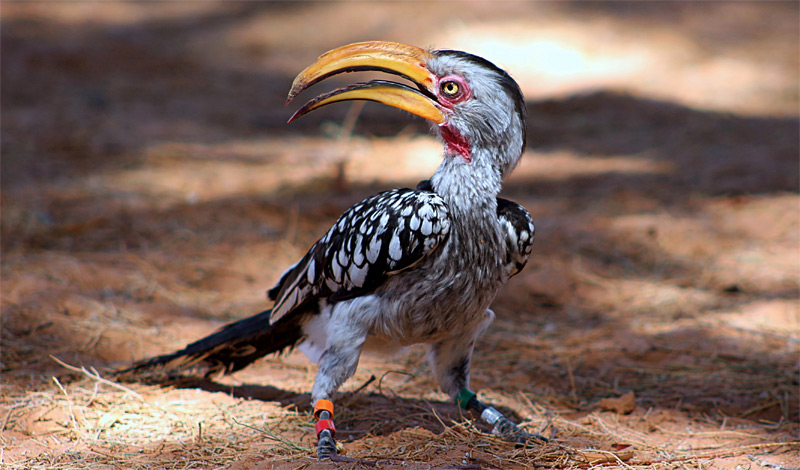
30th May 2022
Southern African hornbill’s survival threatened by 2027
The yellow-billed hornbill of southern Africa – a cousin of Disney character Zazu from The Lion King – is reported to be at risk of local extinction due to rising temperatures in the region.

Southern yellow-billed hornbill. Credit: Nicholas Pattinson
Researchers in South Africa, writing in the journal Frontiers in Ecology and Evolution, have described the effects of rising air temperatures and drought on the breeding success of southern yellow-billed hornbills in the Kalahari Desert. Their data, obtained during the period from 2008 to 2019, reveals clear impacts of the climate crisis on these birds, over a longer timescale than previous studies.
The animals that inhabit these arid regions are already suffering the consequences. For example, earlier research has shown that multiple bird species are breeding earlier and for a shorter amount of time, impairing their reproductive success.
“There is rapidly growing evidence for the negative effects of high temperatures on the behaviour, physiology, breeding, and survival of various bird, mammal, and reptile species around the world,” said first author Dr Nicholas Pattinson, of the University of Cape Town. “For example, heat-related mass die-off events over the period of a few days are increasingly being recorded, which no doubt pose a threat to population persistence and ecosystem function.”
The southern yellow-billed hornbill’s distribution includes most of southern Africa, with a large portion falling within the Kalahari Desert. Known for its peculiar breeding and nesting strategy, the bird is a socially monogamous species. They are cavity nesters; the female seals herself into the nest cavity and stays there for an average of 50 days to brood and care for chicks, with only a narrow vertical slit for an opening, through which the male feeds the female and chicks.
This type of nesting largely protects from predation, which means that breeding success depends primarily on other factors such as climate and food availability. For example, yellow-billed hornbills initiate breeding in response to rainfall, which corresponds with the hottest days of the year. This makes it difficult for them to shift breeding dates outside of the hottest periods.

Kalahari Desert (maroon) and Basin (orange). Credit: Jc86035, CC BY-SA 4.0, via Wikimedia Commons
Pattinson and his team studied a population of southern yellow-billed hornbills at Kuruman River Reserve, with data exclusively collected from pairs breeding in wooden nest boxes. They looked at the breeding success at broad and fine scales (long term trends and individual breeding attempts, respectively). The team also analysed climate trends for the region.
Their results showed that breeding output collapsed during the monitoring period (2008–2019) due to increases in the maximum air temperature.
“During the monitoring period, sub-lethal effects of high temperatures (including compromised foraging, provisioning, and body mass maintenance) reduced the chance of hornbills breeding successfully – or even breeding at all,” explained Pattinson.
When comparing the first three seasons (2008–2011) to the last three (2016–2019), the researchers found that the average percentage of occupied nest boxes declined from 52% to 12%, nest success (raising and fledging at least one chick) declined from 58% to 17%, and the average number of chicks produced per breeding attempt decreased from 1.1 to 0.4.

The species is a close cousin of the red-billed hornbill, made famous by the character Zazu from The Lion King.
No successful breeding attempts were recorded above a threshold air temperature of 35.7°C. Breeding output was negatively correlated with increasing days on which the maximum air temperature exceeded the threshold at which hornbills displayed heat dissipation behaviour and normal breeding and nesting behaviour. These effects were present even in non-drought years.
Current warming predictions at the study site indicate that the hornbill’s threshold for successful breeding will be exceeded during the entire breeding season as early as 2027, according to the researchers. While the bird may persist elsewhere, it could vanish from the Kalahari part of South Africa, one of its main habitats.
“Sub-lethal consequences of high temperatures may drive local extinctions by resulting in recruitment failure (i.e. no young animals joining the population) and changes to the ecosystems on which we all depend,” explained Pattinson. “Much of the public perception of the effects of the climate crisis is related to scenarios calculated for 2050 and beyond. Yet the effects of the climate crisis are current and can manifest not just within our lifetime, but even over a single decade.”
—
• Follow us on Twitter
• Follow us on Facebook
• Follow us on Instagram
• Join us on Reddit
• Subscribe to us on YouTube
Comments »